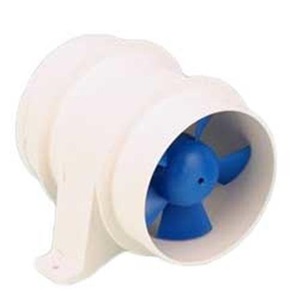Advertisement
A bilge blower is important not only because the USCG may require it, but also because your life may depend on it. The Coast Guard stipulates the use of a mechanical ventilation system for all non-open type boats built after July 31, 1980 which run on gasoline. Even if your boat is older, it still must conform to USCG minimum ventilation levels, and may require a bilge blower to satisfy those guidelines. Also, even if your boat is diesel it should have blowers for extra safety and ventilation of fumes.
Venting your bilge of potentially lethal gas fumes is no job for a jury rig. Bilge blower units are designed and constructed specifically for their life in the trenches — electrical components are "ignition protected" to prevent sparking and causing the explosion that they are installed to avert, and the units are built to withstand overheating and corrosion. However, most bilge blowers are NOT designed for continuous use. They are designed to be run for a short while only. If you run them continuously you may burn them up or even start a fire. There are continuous use bilge blowers available and if you want this (and it can be a very good idea) be sure you get one designed for this and wire it properly.
Bilge blowers are available to move air in two ways — some units feature a squirrel cage configuration, while others favor a "tunnel", or "in-line" design which utilizes a small fan. The type you choose will depend on the space available and on how you plan to mount it. Both types evacuate air very efficiently, and are available in sizes which handle 100-250 c.f.m. (cubic feet of air per minute). The size you need is determined by the volume of your engine compartment (see below). The best plan is usually to have two blowers, one to blow air out and the other to suck outside air into the engine space. However great care must be taken that the outside air intake is free of CO and other fumes.
The minimum recommended time you should run the blower to ventilate the bilge is four minutes. Before switching it on, however, rely on one of the most sensitive odor-detectors you have — your nose. No bilge blower will rid the compartment of spilled fuel, which will continue to emit vapors. Whether your boat is subject to regulations or not, bilge blowers make good sense.
A Rough Guide to Selecting Blower Sizes
For engine spaces up to:
- 70 cu. ft - 100 c.f.m. blower
- 71 to 100 cu. ft. - 150 c.f.m. blower
- 101 to 300 cu. ft. - 250 c.f.m. blower

